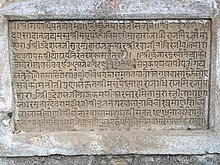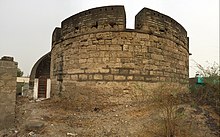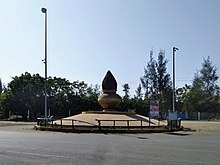Anjar, Gujarat
Anjar | |
|---|---|
Town | |
 Devaliya Gate Circle of Anjar | |
| Coordinates:23°08′N70°01′E/ 23.13°N 70.02°E | |
| Country | |
| State | Gujarat |
| District | Kachchh |
| Established | 650 AD |
| Founded by | Ajepal |
| Elevation | 72 m (236 ft) |
| Languages | |
| • Official | Gujarati,Kutchi,Hindi |
| Time zone | UTC+5:30(IST) |
| PIN | |
| Vehicle registration | GJ 39 |
Anjaris a town,townshipandmunicipalityof theKachchh district(Kutch)in the state ofGujarat,India.Founded in 650 AD, Anjar is a culturally diverse town of historic importance in the region. It is home to several historic religious temples, including the Jesal-Toral Shrines built in honour of a fourteenth century couple, whose lives inspired works of art and cinema. The town was devastated by several earthquakes, including the1819 Rann of Kutch earthquakeand2001 Gujarat earthquake.In recent years, Anjar has become a hub of manufacturing activity.
History
[edit]
The foundation and early history of the town is unclear, due to a lack of written evidence and documentation. Popularfolkloresuggests a group of settlers led by Ajay Pal Chauhan (also called Ajepal) – the brother of the king of neighbouringAjmer– arrived in Anjar in 650 AD (Samvat 707).[1]Soon after, Ajay Pal devoted his life toasceticismafter his Chauhan clan was defeated byMuslim Rajputs.At different points in history, the town was ruled by the Chauhan,Chaulukya,VaghelaandChawda,as well as theJadeja,who gained control of the entireKutchregion. The town was declared the capital of theKingdom of Kutchby KingKhengarji Iin 1545, and wasfortifiedbyDeshalji IIin the early eighteenth century. The fort wall was sixteen feet high and six feet thick.[2]
Anjar was gifted toFateh Muhammadin 1800, who extended the town's trading routes by establishing theTuna Port.[2]The town was attacked byColonel Eastof the BritishEast India Companyon 25 December 1815, with Tuna being occupied the following day. The fort and dependent villages werecolonisedby the British over the following year, with British rule imposed there until 1822.[2][3]The town suffered massively from the1819 Rann of Kutch earthquake,which destroyed or damaged thousands of homes and caused thousands of deaths.[2][3]The population fell shortly afterwards to about 10,000.[3]In 1822, the East India Company transferred the region back to the Jadeja clan in exchange for an annual fee.[3]The payments were a burden on the local treasury, and the entire burden (including arrears) was paid on its behalf by the British government.[3]By 1901, the population of the town had increased to 18,014.[4]
Since the earthquake of 1819, Anjar has endured several other major earthquakes. The town was theepicenterof the1956 Anjar earthquake,which destroyed approximately 1,350 homes and killed around 115 people, injuring hundreds more.[5]The2001 Gujarat earthquakecaused large scale devastation in Anjar. The earthquake resulted in the destruction of the entirety of the "old town" district. 143 people were killed in a single incident when the buildings on both sides of a narrow laneway collapsed on to students as they were celebratingRepublic Day.[6]Around 2,000 people died in Anjar as a result of the earthquake, and over 6,000 families were made homeless.[7]According to official estimates, between 13,805[8]and 20,023 people died – and over 166,000 people were injured – in the Kutch region as a result of the earthquake.[9]The region was drastically redeveloped following the 2001 earthquake.[10]
Demography
[edit]As of the 2011 Indian census, the total population of Anjar is almost 150,000, with amale—female ratioof approximately 90%: 78,000 male to 70,000 female.[11]
Geography
[edit]
Anjar is located at23°06′48″N70°01′40″E/ 23.113424°N 70.027744°Eand has an average elevation of 72 metres (240 ft).[12]The land is mainly dry, arid flatland. In the late 19th century, the town was greatly dependent on wellirrigationfor its water supply, and was listed in the 1878 and 1911 editions ofEncyclopedia Britannicaas being only 10 miles (16 km) north of theGulf of Kutch.[3][4]However, the town is nearly 40 kilometres (20 mi) away from the gulf, and is also 75 kilometres (50 mi) south of theGreat Rann of Kutch,a seasonalsalt marshland.[1]
Climate
[edit]Anjar is in a region classified on theKoppen-Geigersystem ashot semi-arid climate,orBSh.There are three distinctseasonsin Anjar: winter, summer, and therainy season.The town can experience severe winters, which span from November to February with temperatures dropping as low as 4 °C (39 °F). Summer usually begins in March and lasts until July or August, with the town frequently experiencing strongheat waves.Themonsoonseason typically ranges from September to October, when the town experiences the majority of its yearly rainfall. On average, the region receives 400 millimetres (1 ft 4 in) of rainfall per year.[1]
Places of interest
[edit]Temples and Shrines
[edit]
The Madhavrai temple is aVaishnavshrine, with the silver-plated entrance doors bearing an inscription dated Samvat 1869 (1812 AD), presumably the year construction was completed. The temple consists of a domed hallway, a black and white marbled floor and eight pillars featuring carved images of mermaids andNāgafigures. Mohanrai's temple is also a Vaishnav shrine, with a neatly carved wooden door and idols ofKrishnawithRadhaand Chaturbhuj (Vishnu). The temple was extensively rebuilt from 1814 to 1824.[2]Swaminarayan's temple is located near the centre of the town.[13]
Amba Mata's shrine and the adjoining monastery were built from the fragments of older temples; the large red-stone door over the gateway features carved drawings ofDevi,indicating it may have originated from aShaktatemple. The adjoining monastery belongs to the Atits of Ajepal, with an inscription of 1842 on the door. Located outside the town walls, Ajepal's shrine is a small domed room featuring images of Ajepal on horseback andGanesha(Ganpati).[2]

Other temples located near the town include Kalya Mahadev's temple, which is outside the town wall and is comparatively modern, with a dancingYoginias its goddess. To the northwest is theBhavanitemple of Vankal Mata, and to the west the temple of Dvarkanath. Near the latter is an unfinished temple dedicated toBahuchara Mata,with three shrines.[2]
Jesal-Toral shrines
[edit]To the east of Ajepal's monastery is a temple known locally as "Jesal Toral ni Samadhi", translating to "The Tomb of Jesal and Toral". It is a small tiled shed with tombs decorated with Muslim patterns sacred to the fourteenth century couple Jesal and his wife Toral. The shrine is under the care of the Ajepal monastery. Jesal's descendants, known as the Jesar Rajputs, built shrines to the couple in each of the town's twelve villages.[2]
According to local history, Jester (later Jesal or Jesar) was the grandson ofJadejaRagput leaderJam Rawal.Jesal would later become an outlaw: killing people, destroying villages and stealing cattle. Toral or Turi – aKathiwoman – was famous for composinghymnsand for her devotion, as well as her beauty. She lived with an ascetic man named Sávasdhir, who did not consider Toral his wife but instead as someone who would bring salvation. The fame of her beauty reached Jesal, who unsuccessfully attempted to abduct her. After being foiled, Jesal returned to the town disguised as an ascetic, but again his plans to abduct Toral were exposed.[2]
Confessing his plans to abduct Toral to asectwho granted a wish to every confessed sinner, Jesal was offered Toral on condition that he became ascetic. He agreed, but eventually grew tired of the constraints of asceticism, trying again to abduct Toral, who foiled his plans and over time changed Jesal into a model ascetic. Permanently settling in Anjar, Jesar died and Turi was buried alive beside his tomb.[2]The story was the inspiration for the 1971GujaratifilmJesal Toral.[14]
Buildings
[edit]
MacMurdo's Bungalowis a state-protected monument due to the interior wall paintings depicting scenes associated with Krishna andRama.[15]However, the exterior of the building is now in a neglected condition.[16]
Cuisine
[edit]Anjar cuisine is famous both in India and internationally. The local specialty isDabeli,amasala-spiced mashed potato mixture served in aburger bunand garnished withpomegranateseeds or peanuts, and served with a variety ofchutney.Farsanis another local delicacy. Anjar is also home to region-specific varieties ofmango(Kesar Keri) anddate palmfruit (Kharek). The region also produces a locally-sourced form ofbuttermilkknown as "Chhash".[1]
Economy
[edit]
Following the 2001 earthquake, the government in Kutch created a number of initiatives that greatly benefited the community in Anjar. Local government exempted all business operations fromtaxes,includingexcise dutyandindirect tax,for five years after the earthquake. Textile companyWelspun Indiabuilt the largest towel factory in the world in Anjar nine months after the earthquake. The factory was producing 250,000 towels a day by 2011, when theBBCreported that the company had purchasedChristy,the official towel provider of theWimbledon Championships.A decade after the earthquake, over 110,000 jobs had been created in the Kutch province.[10]Anjar is also one of the largest manufacturers ofpipelinein the world. In 2006, the town produced over one million tonnes of pipeline, primarily for the oil, gas, water and sewage industries.[17]
Culture
[edit]
The people of Anjar come from a wide variety of backgrounds. The three most populous religions areHindu,JainandIslam.Gujarati,KutchiandHindiare the most commonly spoken languages. Major festivals from multiple religions are celebrated in the town, includingHindola,Navaratri,Ram Navami,Sharad Purnima,Diwali,Holi,Eid al-FitrandRamadan.[1]
Notable people
[edit]Several members of theKutch Gurjar Kshatriyacommunity in Anjar made substantial contributions to theIndian railway system.Jagmal Pitambar Rathod was dubbed a "Gaidher"(English:" Chief Architect ") in 1750 byLakhpatji,theRao of Cutch,for his work creating thefortsurrounding Anjar. Sons from three subsequent generations of Rathod's family – who all resided in Anjar – were also awarded the "Gaidher" title, for their work building the forts of nearby townsBhujandMandvi,as well as their work building the palacesAina Mahal,Prag Mahal,Vijay Vilas,and theAshapura Temple,among others. ThePamban Bridge,which links the southern island ofRameswaramto the Indian mainland, was designed by Manji Daya Vegad and Lakhu Devji Vegad, who were both born in Anjar. They also designed other railway lines in the south of India. Narshi Bechar Khodiyar, the son of Anjar-born Bechar Hardas, was given thetitle of honour"Rai Sahib"by the British in 1920, for his contributions to railway engineering.[18]
Villages in Anjar
[edit]In total, there are 66 villages in theAdministrative division( "Taluka") of Anjar, including, among others:Amrapar,Bhalot,Chandiya,Chandroda,Devaria,Khambhra,Khedoi,Khokhra,Kotda Nayani,Kumbhariya,Lakhapadar,Lovariya,Meghpar,Mindiyana,Nagalpar,Pantiya,Ratnal,Sanghad,Sinugra,Tuna,VidiandVira.[11]
Notes
[edit]- ^abcde"About Anjar | Culture and Climate".Gujarat Online.Archivedfrom the original on 19 September 2022.Retrieved8 September2022.
- ^abcdefghijGazetteer of the Bombay Presidency: Cutch, Palanpur, and Mahi Kantha.Printed at the Government Central Press. 1880. pp. 210–211.Archivedfrom the original on 20 February 2017.Retrieved29 October2016.
- ^abcdefEB (1878).
- ^abEB (1911).
- ^J.R. Kayal (2008).Microearthquake Seismology and Seismotectonics of South Asia.Springer Science+Business Media.p. 393.ISBN978-1-4020-8180-4.Archivedfrom the original on 7 September 2022.Retrieved7 September2022.
- ^"15 years of Gujarat earthquake: A trauma etched in Gujarat's memory".The Times of India.26 January 2016.Archivedfrom the original on 29 March 2019.Retrieved7 September2022.
- ^"Anjur Remembers Its Dead Children".The Times of India.26 January 2002.Archivedfrom the original on 7 September 2022.Retrieved7 September2022.
- ^Ray Joydeep (16 April 2004)."Gujarat to set up quake memorial in Bhuj".Business Standard.Archivedfrom the original on 15 April 2019.Retrieved6 September2022.
- ^USGS (4 September 2009),PAGER-CAT Earthquake Catalog,Version 2008_06.1,United States Geological Survey,archivedfrom the original on 10 April 2021,retrieved6 September2022
- ^abBhasker Solanki; Emily Buchanan (30 January 2011)."Gujarat's astonishing rise from rubble of 2001 quake".BBC News.Archivedfrom the original on 24 April 2022.Retrieved6 September2022.
- ^ab"Anjar Population (2021/2022), Taluka Village List in Kutch, Gujarat".IndiaGrowing.Archivedfrom the original on 11 September 2022.Retrieved8 September2022.
- ^"Maps, Weather and Airports for Anjar, India".Falling Rain Genomics, Inc.Archivedfrom the original on 3 June 2019.Retrieved8 September2022.
- ^Gopal Kateshiya (28 August 2022)."For Anjar residents, memories of dreadful quake hauntingly fresh".The Indian Express.Archivedfrom the original on 11 September 2022.Retrieved11 September2022.
- ^K. Moti Gokulsing;Wimal Dissanayake(17 April 2013).Routledge Handbook of Indian Cinema.Routledge.p. 95.ISBN978-1-136-77284-9.Archivedfrom the original on 25 May 2022.Retrieved11 September2022.
- ^"અંજાર રાહ જુએ છે, ૨૧મી સદીના મેક મર્ડોની".Gujarat Samachar(in Gujarati). June 2016. Archived fromthe originalon 19 September 2016.Retrieved19 September2016.
- ^Azera Parveen Rahman (29 September 2018)."The walls have years".The Hindu.Archivedfrom the original on 11 September 2022.Retrieved11 September2022.
- ^Swaminathan S. Anklesaria Aiyar (8 April 2006)."Anjar: new global pipeline hub".The Times of India.Archivedfrom the original on 9 March 2022.Retrieved12 September2022.
- ^Govindji, Nanji (1999).નાનજી બાપા ની નોંધ-પોથી[Nanji Bapa ni Nondh-pothi (Notes from Nanji Bapa)] (in Gujarati).Vadodara:Vadodara Publishing House. pp. 3–5.
References
[edit]- Baynes, T. S., ed. (1878),,Encyclopædia Britannica,vol. 2 (9th ed.), New York: Charles Scribner's Sons, p. 58
- Chisholm, Hugh,ed. (1911),,Encyclopædia Britannica,vol. 2 (11th ed.), Cambridge University Press, p. 55



